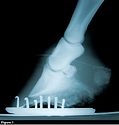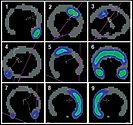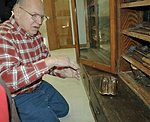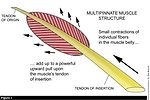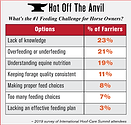Advertise Follow Us
American Farriers Journal

View Archived Issues
July/August 2020
Volume: 46
Edition: 5
American Farriers Journal is the “hands-on” magazine for professional farriers, equine veterinarians and horse care product and service buyers.
-
Table Of Contents
Table Of Contents
Biosecurity Protocols Limit Disruptions for Indiana Farrier During COVID-19 Pandemic
Effective client communication keeps Cody Bogard’s focus on providing solid hoof careRead MoreStrategies for Troubleshooting Soft Tissue Injuries in the Western Performance Horse
Thorough lameness evaluations and thoughtful shoeing prescriptions play a key role in helping horses recover from soft tissue injuriesRead MoreObservationsThink Again Before Trimming a Negative Palmar Angle Foot
Has the reliance on radiographs removed common sense before we pick up a foot?Read MoreWhat Influences a Farrier’s Shoe Choice?
Farrier Wayne Preece discusses shoe types and criteria for choosing the right application.Read MoreFarrier-Client Partnership Brings Horse Back to Soundness
Infection, dead coffin bone and contralateral limb rotation test Florida farrier’s skills and client’s follow-throughRead MorePressure Plate Analysis Measures Dynamic Weight Distribution
Ghent University researcher’s findings can influence trimming and shoeing for individual hoof-care casesRead MoreSimple but Effective Ways to Shear Bar Stock
Bruce Daniels’ techniques continue to hold up more than 40 years laterRead MoreEffects of Trimming on Shape and Dimensions of the Hoof Capsule as Well as on the Phalangeal Alignment
Focus should be on biomechanics, the horse and its environmentRead MoreEquine Reciprocating Systems: Do You Know the Nuts and Bolts of the “Orthopedic Trim?”
Farriers test their knowledge about how the forelimb functionsRead MoreSpring 2020 Data Shows Farriers Largely Unaffected by COVID-19
Farriers report that COVID-19 has resulted in the same number or more clients seeking serviceRead MoreResearch Journal: July/August 2020
The information, ideas and opinions expressed are those of the author and do not necessarily represent those of the United States Department of Agriculture.Read More -
Featured Articles
Featured Articles
Biosecurity Protocols Limit Disruptions for Indiana Farrier During COVID-19 Pandemic
Effective client communication keeps Cody Bogard’s focus on providing solid hoof careRead MoreObservationsThink Again Before Trimming a Negative Palmar Angle Foot
Has the reliance on radiographs removed common sense before we pick up a foot?Read MoreStrategies for Troubleshooting Soft Tissue Injuries in the Western Performance Horse
Thorough lameness evaluations and thoughtful shoeing prescriptions play a key role in helping horses recover from soft tissue injuriesRead More - Digital Edition
-
Online Extras
Online Extras



